
the cornucopia
the elusive pen S 3.5
copyright the olympus circle/john foster

the cornucopia the elusive pen S 3.5 copyright the olympus circle/john foster |
|
|
INTRODUCTION: This article is about an elusive camera from the Olympus stable from the 60's, the Olympus Pen S 3.5, and appeared in Quest, the Magazine of The Olympus Circle, in March 2004 issue No 3. It examines in detail the peculiar serial numbering attached to this camera and draws on further research done by the author and Olympus aficionado, John Foster. ~~~~~~~~~ |
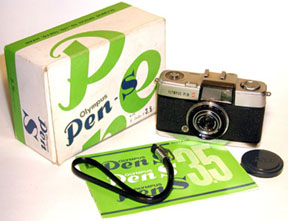
A rare sight - boxed Pen S 3.5 with all the trimmings |
When it comes to the rarer viewfinder Pens many believe the Pen Wide is the rarest. Not so, there are much rarer Pens than the pretty Pen W, but there are few as enigmatic as the Pen S 3.5. Be under no illusion, this is a mainstay production camera enjoying a production period of 32 months and taking over from the immensely popular Pen S 2.8, so why is it so difficult to find one? In my many years of collecting in UK and watching the Internet auction houses I have seen no more than around 6 but in the same time I have seen scores of Pen W (and owned a few). My record of Pen production numbers show 21,100 Pen W and 77,600 Pen S 3.5, over 3½ times as many, yet my own and many other collectors’ observations suggest they are rare, and I for one wonder why? If, as a collector of the charming Olympus viewfinder Pen half-frame series of cameras, you have one in your collection, this article may ring a familiar note. But there are many collectors who will be surprised that the highly prized but quite common Pen S 2.8 has a production-line sibling. Introduced as the direct successor to the Pen S 2.8, which ceased in December 1964 after 55 months of continual production and around 300,000 made averaging 5,500 per month, the Pen S 3.5 version was made from January 1965 to August 1967, being produced at an average rate of 2,425 per month. Looked at in a holistic sense the production figures tell us only two things; the Pen S 3.5 was made for over half the time of its predecessor but its monthly output was down by over half. Looking at the overall production numbers there are nearly four times the amount of Pen S 2.8’s so, statistically, for every four Pen S 2.8’s you see the next one seen should be a Pen S 3.5. But this is simply not so. |
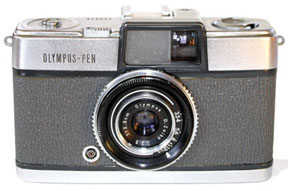
Almost first in the line of mechanical Pens; The Olympus Pen 2 Lug. |
There seems to be some general confusion about the second Pen S. Although it is well documented in all major reference books, McKeowns [inaccurate] description might hold a clue. It says ‘the second model of the Pen S with a 30mm [should be 28mm] x f3.5 lens appeared at the time the original Pen was discontinued. It is basically the same except for the shutter speeds.’ True, but what can we draw from this? Was the introduction of the second Pen S model seen by the public as a rouse by the company to sell the old Pen with a slightly improved shutter and black covers as a ‘S’ designated camera, somehow belittling the fine reputation of the ‘true’ Pen S 2.8? This might explain why it was never as popular. It might also go some way to explain the confusion between the second Pen S and the ordinary Pen. [left] Ignoring the obvious fact that the ordinary Pen is overall grey the cameras are remarkably similar. Same lens specification, same basic look, same weight and feel, same plastic type viewfinder surround; I can see where the confusion lies. Add to this the fact that many dealers do not know or acknowledge there are two versions, (presumably because they have never seen the 3.5 version - above) and perhaps we have the beginnings of an excuse. But it still does not explain why so many collectors have failed to find one. |
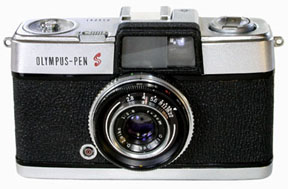
The Olympus Pen S 2.8 - black covers |
I had been collecting many years before I obtained an example and initially put this down to regional or national differences but when I appealed for information for my first Pen book I was surprised that only one contributor sent details of his example when (for instance) I had full data on some 20+ Pen Wide. When I learned other major collectors considered them elusive too I began to wonder ‘What is it about this camera that makes it appear so rare?’ Of course from that point on I looked even harder and asked many more people but all this effort failed to increase the presence of the Pen S 3.5. My conclusion at the time was the Pen S 3.5 had not sold well. But if this were true why keep it on the production line for 32 months? Perhaps this is just perception from my viewpoint. I’ve coined a phrase for such peculiarities that goes ‘Rarity is in the eye of the non-beholder’ which is very true when you start, but gets less so the more complete your collection becomes. In other words, in the early days, just because you haven’t seen one doesn’t automatically make it rare. Contrarily however, long term collectors’ opinions are always valued, especially if there is no production information available. Believing I fit into this category I can’t get away from the fact that over 20 years I’ve seen very few of these cameras. |
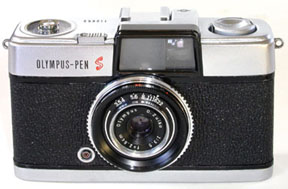
The Olympus Pen S 3.5; also black covers |
Before moving on you will have noticed I refer to my records of Pen production numbers. Those of you who have read my books will know that for many years I have collected Pen serial number and date codes and this allows me to make some statistical predictions about overall numbers made. When I wrote about the Pen S 3.5 in 2000 my database of numbers contained only 2 records for this camera and only 1 was complete. I undertook a very unsafe analysis based on details from my own example numbered 134369, dated Jan 1966 that predicted 91,700 made, which as it happens was not too far away. Having recently obtained a second example that is serial number 112652 and dated March 1965, I can undertake a much safer prediction indicating some 63,200 made. This is done: 134369 [Jan 66] - 112652 [Mar 65] = 21,717 in 11 months = 1975/month x number of months in production [32] = 63,200 [Raw.] If the two statistical predictions are averaged the predicted output is an almost perfect 77,450 [Smoothed.] Now it so happens that during my last minute scramble with Olympus Japan in 2000 just prior to publishing my book, Olympus sent me some production details. In the overall sense these could not be rationalised at the time and it was agreed that little purpose would be served by making them public. However the numbers of Pen S 3.5 made, according to the company, was some 77,600 - a figure that seemed incredibly low following the success of its predecessor the Pen S 2.8. The statistical equations above and the data from Olympus support each other underlining that there are no mistakes in data relating to Pen S 3.5. NOTE: None of this implies any criticism of the company records for, as pointed out at the time, the production data has been held in many files by many people, is 40 years old, has been subject of many transfers and computerisation, and cannot be guaranteed complete let alone correct. We now know the output figure of 77,600 pieces of Pen S 3.5 to be true, so its seeming rarity is not a case of small numbers like Pen W. So why is this camera so elusive? Quite simply I don’t know. It was advertised and available in all parts of the world at the time, which might dispel any thoughts about only being available to Australasia for example. Is the reason that when it was made available it appeared to be the ‘bottom of the range’ model, not far removed from the original and ‘cheap’ ordinary Pen and has been treated as disposable? Well, perhaps. |
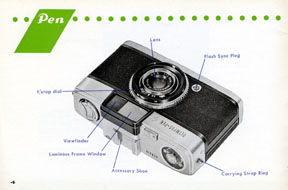
Scan of the Pen S 3.5 Handbook; Note the lens fitted here is clearly a 2.8! |
But before leaving you to think about it there is one further aspect of the Pen S 3.5 which I find equally mysterious. It is a well known fact that Olympus numbers its products starting at 100,000. If the product has only been upgraded the company might re-set the counters at the next available whole-number point in the general progression. For example: Pen S 2.8 first run 100,000 to 210,237 then a design upgrade with the appropriate manufacturing line adjustment followed by the second run starting the counters at 211,000. The Pen S 3.5 was a ‘new’ product and, as evidenced by the two examples quoted in this article, the production counters started at 100,000. |
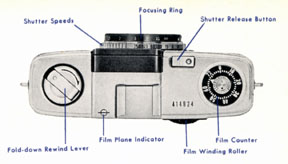
Scan from the Pen S 3.5 Handbook; The altered serial number. |
But in the S 3.5 handbook the camera shown in all the illustrations is numbered 414,824. My book speculated that the reason might be the handbook referred to is a re-print dated May 1969 – well after the Pen S 3.5 was deleted – and Olympus might have used an archived camera to illustrate it. This cannot be as we now know such a high serial number is impossible based on 100,000 + 77,600. In any case I have since seen a very early handbook dated January 1965 and the illustrations are identical. When examined carefully the illustration appears to have been ‘touched up’ with the first digit being changed from a 1 to a 4. In addition the lens size shown in the above scan is more like the 2.8 than the 3.5. If you look carefully you can see the first digit 4 has been achieved by altering the first 1. The second 4 also appears to have been altered. (This is a true untouched scan straight from the May 1969 handbook.) The first ‘4’ is decidedly darker and out of line with the other digits. If true this camera is number 111824. We know that serial numbers are machine stamped so any deviance from perfect is noticeable. Why Olympus should go to such lengths is a complete mystery. DESIGN BACKGROUND: [Thanks to Biofos Publications.] I had always considered fitting a slower lens to a camera that had built its reputation on the quality of its optics was a retrograde step. However Mr Maitani soon put me right on this issue! When I asked him the reason for what appeared to be a backward step he replied, “It was because a good quality shutter for the Pen S was fitted to the f3.5 lens.” |
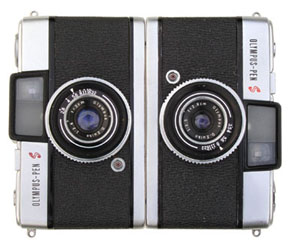
Direct comparison - Pen S 2.8 and 3.5 |
I had lost sight of the designers original concept, that of a small, smooth and pocketable camera. Whilst the Pen S 2.8 offered some technological advance over the Pen, in terms of a brighter lens, this was at the expense of bulk and weight. The Pen S 2.8 [right] dimensions are 108mm x 68mm x 44mm, weight 400g. Its production sister, the ‘ordinary’ Pen is 108mm x 68mm x 39mm, weight 350g. This increase may not appear very much, but to the designer who had spent months reducing the size, weight and bulk of his camera the additional 10% on depth and 14% weight must have seemed dramatic. The Pen S 3.5 redressed the balance. By fitting the modified shutter fitted to the acclaimed but now defunct Pen Wide to a F3.5 lens this allowed the designer to re-capture some of his original concept. The Pen S 3.5 dimensions are 108mm x 68mm x 40mm, weight 370g, only marginally above the Pen Original. The Pen S 3.5 has more in common with the Pen Wide than the Pen S 2.8. Sharing the same basic body the Pen S 3.5 might appear to be a direct derivative of the 2.8 version, but see notes above. Other changes are subtle. The viewfinder surround is now made of black plastic rather than the black crackle finished casting of the 2.8. The film pick up spool on the Pen 3.5 S is black whereas on the Pen S 2.8 it is grey; however this tends to repeat itself in earlier Pens without logic and must reflect the possibility that two colours were generally available to the production line. The fundamental difference is that of shutter and lens configuration and a return to the designer’s original concept. I note that the body covers are black grained leatherette and not basket weave, which was available and fitted to the Pen D from June 1962. This may be just good housekeeping by Olympus, using existing stocks, but I note it in any case. |
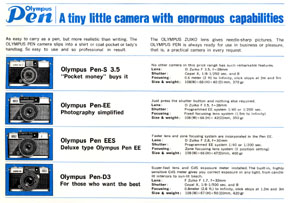
Scan from the Pen S 3.5 Handbook - the 'Pocket Money' camera |
In addition I would add a further difference noticed, that of the number of blades making up the iris diaphragm. The Pen S 2.8 uses 6 blades [right] giving a smoother shaped diaphragm in line with its faster optic. The Pen S 3.5 reverts to the previous 4 bladed diaphragm [left] of the ordinary Pen. I have no doubt that those of you with “easily” found examples of the Pen S 3.5 will berate me for spending so much time on it in this Centrepiece. If so I will be delighted to receive any details of your example for the database and perhaps your opinion as to the cameras perceived rarity. Left: From contemporary advertising material July 1967. Note the Pen S 3.5 is a ‘pocket money’ camera and appears to be the bottom of the range. Thanks to John Foster, Editor, Quest (author) and the Executive Committe of The Olympus Circle in whom copyright vests. |
|
|
|
HOME |
INTRO |
BOOKS |
OLYMPUS CIRCLE |
QUEST |
TOC MEMBERS |
GALLERIES
|
| Posted 17/09/2005 | Copyright © 2005 John Foster |